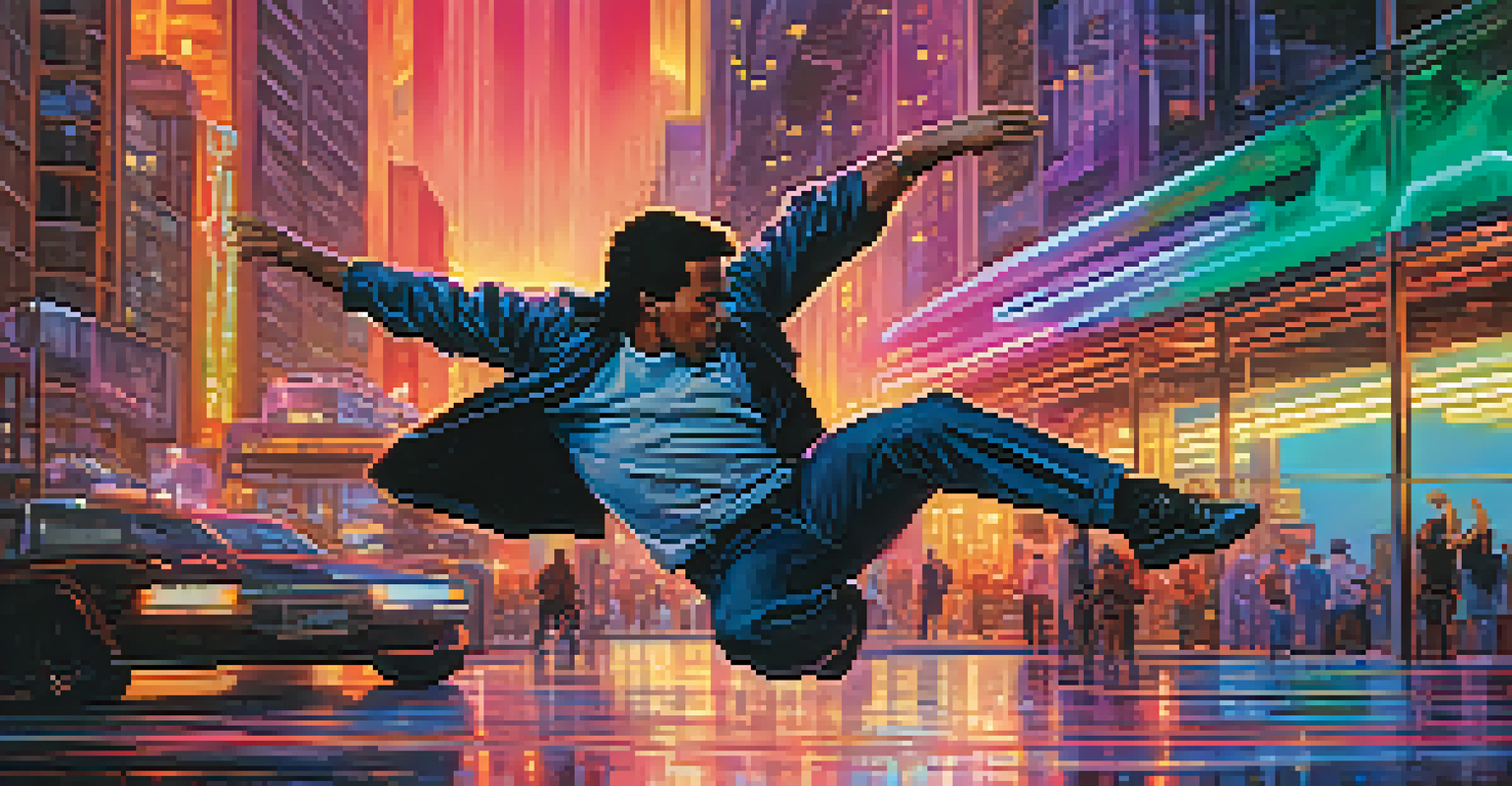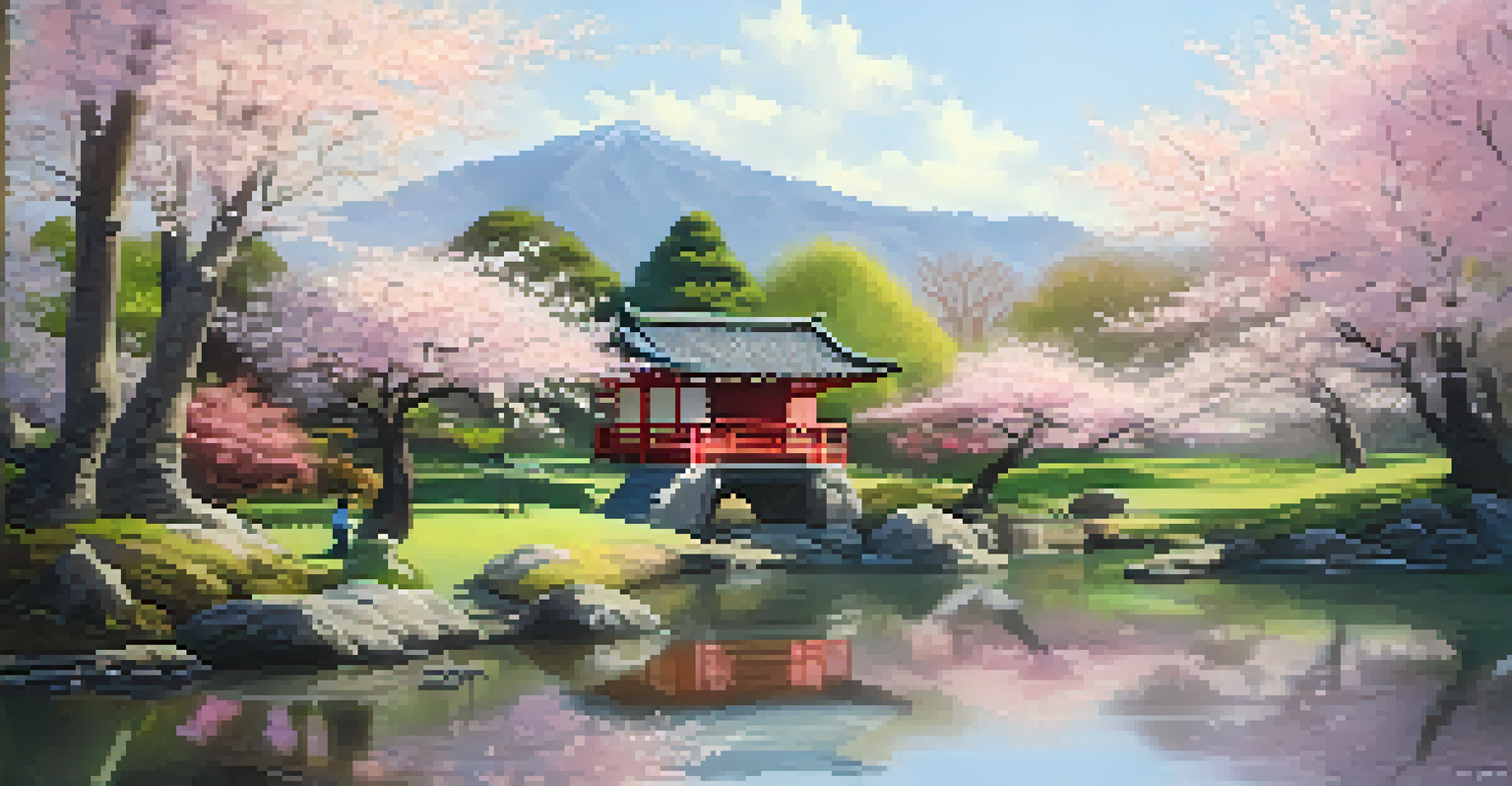How Japanese Cinema Shaped American Action Films' Aesthetic

The Roots of Action Cinema: A Cultural Exchange
Japanese cinema, particularly in the mid-20th century, introduced innovative storytelling and visual styles that caught the attention of film lovers worldwide. Films like Akira Kurosawa's 'Seven Samurai' not only showcased epic battles but also deep character development, which was somewhat new to Western audiences at the time. This cultural exchange fostered a growing interest in how storytelling could transcend borders, paving the way for a unique blend of cinematic styles.
Cinema is a matter of what's in the frame and what's out of the frame.
As American filmmakers began to explore these influences, they realized that the raw emotion and intensity found in Japanese films could enhance their own narratives. The complexity of characters and moral dilemmas presented in films such as 'Yojimbo' offered fresh inspiration for Hollywood writers looking to create more compelling protagonists. This blend of Eastern and Western philosophies in storytelling sparked a new era in action cinema.
Moreover, the visual aesthetics of Japanese films, with their striking compositions and dynamic camera movements, encouraged American directors to rethink their approach to action sequences. The combination of narrative depth and visual flair created an intriguing template that would shape future action films, creating a dialogue between two distinct cinematic traditions.
The Influence of Samurai Films on American Action Heroes
The samurai genre, with its emphasis on honor, duty, and inner conflict, laid the groundwork for the archetypal American action hero. Characters like Toshiro Mifune in Kurosawa's films embodied a moral complexity that resonated with audiences, inspiring American counterparts such as Clint Eastwood's iconic roles. This shift towards a more layered hero allowed American filmmakers to explore themes of redemption and sacrifice, making their narratives more relatable and engaging.

Furthermore, the aesthetic of samurai films, characterized by their meticulous choreography and stylized combat, significantly impacted American action sequences. The use of slow-motion and dynamic fight choreography was a hallmark of Japanese cinema that filmmakers like John Woo adopted in their films. This not only heightened the visual appeal but also added a sense of artistry to action scenes, blending form and function seamlessly.
Cultural Exchange Shapes Action Cinema
The fusion of Japanese and American cinematic styles has enriched storytelling and visual aesthetics in action films.
As American audiences became enamored with these heroic figures, the samurai's code of ethics began to seep into the fabric of American storytelling. This led to the emergence of action films that celebrated both physical prowess and moral integrity, showcasing heroes who were not just fighters but also deeply principled individuals.
Cinematic Techniques: Borrowing from Japanese Aesthetics
Japanese filmmakers have long excelled in utilizing innovative cinematic techniques that create a unique viewing experience. Techniques such as long takes, minimal cuts, and the use of natural landscapes have been masterfully employed in films like 'Rashomon' and 'Ran'. These elements not only enhance the storytelling but also immerse the audience in the film's world, a lesson that American directors eagerly adopted.
The only thing that matters is that you make a movie that resonates with people.
As American action films started to embrace these techniques, the impact was profound. Directors like Quentin Tarantino and the Wachowskis incorporated long, sweeping shots and stylistic editing that echoed the elegance of Japanese cinema. This shift in technique contributed to a more immersive action experience, inviting audiences to engage with the narrative on a deeper level.
Additionally, the strong emphasis on visual storytelling in Japanese cinema encouraged American filmmakers to prioritize aesthetics in their action sequences. This focus on creating visually striking moments led to the development of iconic scenes in films like 'The Matrix' and 'Kill Bill', which are now celebrated for their artistry as much as their action.
The Rise of Anime and Its Impact on Live-Action Films
Anime, a distinct genre of Japanese animation, has also left a significant mark on American action films. With its vibrant visuals and imaginative worlds, anime has inspired filmmakers to embrace a more stylized approach to storytelling. Works like 'Akira' and 'Ghost in the Shell' have captivated audiences and served as blueprints for integrating animated aesthetics into live-action narratives.
The influence of anime is evident in the way American films have adopted exaggerated action sequences and fantastical elements. Directors have begun to incorporate anime-inspired visuals to create a heightened sense of reality, enhancing the overall experience for viewers. This blending of styles has resulted in films that feel fresh and dynamic, appealing to a broad audience.
Samurai Influence on American Heroes
The moral complexity and honor depicted in samurai films have inspired deeper character development in American action heroes.
Furthermore, anime's exploration of complex themes such as identity and existentialism has encouraged American filmmakers to delve into deeper philosophical questions within their narratives. This thematic depth, paired with visually striking sequences, has enriched the landscape of American action cinema, creating films that resonate on multiple levels.
Cultural Themes: Honor, Duty, and Conflict
Themes of honor and duty prevalent in Japanese cinema have profoundly influenced American action films. These concepts often manifest in the struggles of the protagonist, who must navigate personal and societal expectations. This moral complexity added a layer of depth to American narratives, allowing filmmakers to explore the internal conflicts that arise from these themes.
In films like 'The Last Samurai' and '47 Ronin', we see the direct influence of Japanese cultural themes on American storytelling. Characters grapple with their sense of duty while facing external forces, reflecting the struggles depicted in samurai films. By weaving these themes into their narratives, American filmmakers created more relatable and impactful stories that resonate with audiences.
Moreover, the portrayal of conflict in Japanese cinema often emphasizes the idea of personal sacrifice for a greater cause. This notion has inspired American action films to highlight characters who are willing to put their lives on the line to protect their loved ones or their beliefs. This shared value of sacrifice and commitment adds emotional weight to action sequences, making them more than just spectacles.
The Sound of Action: Music and Sound Design
The soundscapes of Japanese cinema have also played a crucial role in shaping the aesthetic of American action films. The use of traditional Japanese instruments and innovative sound design creates an immersive experience that enhances the film's emotional impact. Filmmakers have recognized the importance of sound in storytelling, leading to a more nuanced approach in their own productions.
American directors have begun to incorporate elements from Japanese soundtracks, blending orchestral scores with contemporary music to create a unique auditory experience. This fusion not only elevates the action sequences but also deepens the emotional connection between the audience and the characters. The result is a richer cinematic experience that lingers long after the credits roll.
Visual and Sound Innovations Adopted
American filmmakers have embraced Japanese techniques in visuals and sound design, enhancing the emotional impact of their narratives.
Additionally, the strategic use of silence and ambient sound in Japanese films has influenced American filmmakers to experiment with sound design. By allowing moments of quiet tension to build, directors can create an atmosphere that heightens the stakes in action scenes. This newfound appreciation for sound has led to a more holistic approach to filmmaking, where every element contributes to the overall aesthetic.
Conclusion: A Lasting Legacy of Influence
The influence of Japanese cinema on American action films is a testament to the power of cultural exchange in the film industry. From storytelling techniques to visual aesthetics and thematic depth, the impact is undeniable and continues to evolve. As filmmakers draw inspiration from these rich traditions, the boundaries between cultures blur, creating a more diverse cinematic landscape.
As we look toward the future, it's clear that the legacy of Japanese cinema will remain a vital force in shaping American action films. The blending of styles and influences will undoubtedly lead to new and exciting narratives that resonate with audiences across the globe. This ongoing dialogue between East and West offers limitless possibilities for creativity and innovation in filmmaking.

Ultimately, the aesthetic evolution of American action films, inspired by Japanese cinema, serves as a reminder of the interconnectedness of cultures. As filmmakers continue to explore and celebrate these influences, we can expect to see even more captivating stories that reflect the rich tapestry of our shared human experience.